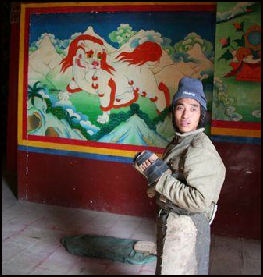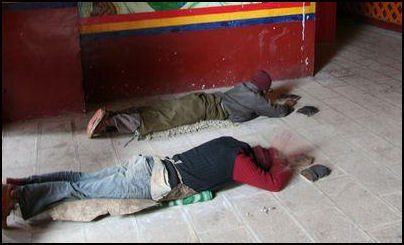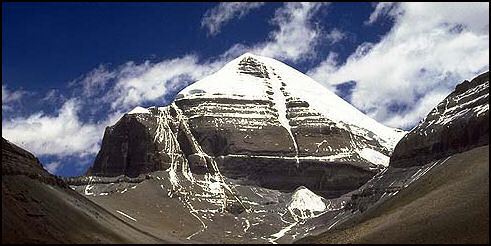TIBETAN BUDDHIST PILGRIMS

Pilgrimages to religious sites are of great importance to Tibetan Buddhists. Approached with the same religious zeal as Muslims going to Mecca, they are seen as both a religious duty and a chance to earn merit, plus a time to enjoy oneself and maybe an opportunity to seek a cure to an illness for themselves or a loved one. Pilgrimage sites generally have pilgrimage paths (koras) lined with prayer wheels and mani stones. Thus pilgrimages involve getting to the pilgrimage site itself and performing a pilgrimages around the site once there.
Tibetans go on pilgrimages out of deep devotion to their faith — Buddhism — to accumulate merit or good luck — perhaps in the hope of winning a better rebirth, curing an illness, turn one’s luck around, or to fulfilling a promise to bodhisattva for granted a wish. In Tibet there are countless sacred destinations, ranging from lakes and mountains to monasteries and caves that once served as meditation retreats. Specific pilgrimages can be recommended for specific problems; certain mountains, for example, expiate certain sins.
The status of a pilgrims can be identified by their headgear, clothes, robes, earrings or the way their hair is braided. Pilgrims used to walk or make their way on horseback to the pilgrimage sites but now they arrive in buses and trucks.
See Separate Articles: TIBETAN BUDDHISM factsanddetails.com; TIBETAN BUDDHIST OBJECTS: MANI STONES, PRAYER WHEELS AND HUMAN BONES factsanddetails.com; TIBETAN BUDDHIST RITUALS, CUSTOMS AND PRAYERS factsanddetails.com
RECOMMENDED BOOKS: “Pilgrim” by Richard Gere and Dalai Lama Amazon.com; “To a Mountain in Tibet” by Colin Thubron Amazon.com “The Path to Buddha: A Tibetan Pilgrimage” by Steve McCurry Amazon.com; “Kailash: Pilgrimages to the Tibetan Mystic Mountain” by Heli Grauberg and Sireliis Vilu Amazon.com; “Tibet's Sacred Mountain: The Extraordinary Pilgrimage to Mount Kailas” by Russell Johnson and Kerry Moran Amazon.com; “Tibetan Pilgrimage” by Peter Gold Amazon.com; Tibetan Buddhism: “Essential Tibetan Buddhism” by Robert A. F. Thurman Amazon.com; “Initiations and Initiates in Tibet” by Alexandra David-Neel Amazon.com; “The Secret Oral Teachings in Tibetan Buddhist Sects” by Alexandra David-Neel, Lama Yongden Amazon.com; Introduction to Tibetan Buddhism by John Powers Amazon.com; “The World of Tibetan Buddhism: An Overview of Its Philosophy and Practice” by His Holiness the Dalai Lama, Geshe Thupten Jinpa Amazon.com; “Tibetan Buddhism: With its Mystic Cults, Symbolism and Mythology, and in Its Relation to Indian Buddhism” by L Austine Waddell Amazon.com; “The Jewel Tree of Tibet: The Enlightenment of Tibetan Buddhism” by Robert Thurman and Sounds True Amazon.com; “A Concise Introduction to Tibetan Buddhism” by John Powers Amazon.com; “The Preliminary Practices of Tibetan Buddhism” by Geshe Rapten Amazon.com; “Teachings and Practice of Tibetan Tantra” Amazon.com; “Tantra in Practice” by David Gordon White Amazon.com
Pilgrimage Life in Tibet
Some pilgrims travel thousands of miles in the backs of old trucks to get to pilgrimage sites. Often times much of the traffic you see on Tibetan roads is made up of trucks filled with pilgrims on their way to religious sites. They often bring their children, what little money they have and meat and vegetables to sell at a market to help pay for their trip.
Tibetans begin doing pilgrimages when they are children and do not stop doing them until they reach the end of their life. Ceasing to do pilgrimages is ceasing to engage the life on earth from the view of a Tibetan. Describing pilgrims at Potala Palace in Lhasa, Howard French wrote in the International Herald Tribune, “Tibetans arrive by the thousands just as they always have dressed in crimson robes, or more often, well-worn rags, leaning on walking sticks or clutching babies. Many of them have journeyed a week or more to make the pilgrimage, often traveling from villages so remote they are not served by roads, wearing looks of beatitude upon arrival at the palace.”
Pilgrims move in a clockwise direction around temples and shrines. In addition to prostrating themselves, they also drape white and yellow gauze strips around statues, spoon yak butter into lamps, turn prayer wheels, and leave small banknotes and barley grains as offerings. Many pilgrims wear an amulet called a gau that holds a picture of the Dalai Lama or the owner’s protector god. Pilgrims visiting a lamasery customarily leave a prayer scarf to honor the monasteries founding lamas. Swathes of sheep wool are sometimes hung to ensure a good harvest. The mangy dogs found around many temples survive off of hand-outs given by pilgrims.
Begging Pilgrims in Tibet
In Tibet, begging is not seen as something poor people do to get food but rather a sacred activity for pilgrims similar to what the Buddha did when he was went through his holy man stage and was a wandering teacher. manner. Tibet has a long tradition of begging for alms. In the past, two rows of huts were built to give shelter to beggars at the end of Barkor Street in front of the present-day Tibet Hospital. Lines of blind beggars linked together by a rope were led by a dim-sighted beggar, chanting and singing in deep and low voices. Today, monks sometimes sit along the street cross-legged, chanting sutras and begging for alms. In front of each is a long horizontal piece of cloth with quotations from the Buddhist scriptures written on a particular theme. The are also some child beggars and some are pilgrims from other places, who are spinning a prayer wheel and begging for alms. [Source: Chloe Xin, Tibetravel.org]
Some Tibetan pilgrims travel for months to reach Lhasa to worship at the city’s sacred temples. No matter how rich they are, they do not carry lots of money for their pilgrimage. They beg all the way to their last destination, and do the same when they return home. Even the rich monasteries send monks out to ask for alms.
Some beggars in Tibet are not begging for themselves but for sacred temples, holy mountains and lakes. After begging for tens of years, they spend thousands of yuan to plate the Buddha of Sakyamuni with gold, or throw jewelry valued tens of thousands of yuan into holy lakes. Therefore, Tibetan people never skimp on giving alms to beggars. It is considered meritorious to give alms. But tourists may sometimes find themselves being pestered by the beggars.
Prostrating Tibetan Buddhist Pilgrims

prostrating pilgrims
Pilgrims have spent several years making pilgrimages to Lhasa and other religious centers from distant places in Tibet, covering the entire distance in a series of prostrations. Theses pilgrims often wear rawhide knee pads, gloves and wooden planks attached to their hands and have greasy, dirty robes. They advance forward by lowering themselves to the ground and extending and stretching themselves on the ground, scrambling to their feet, taking two steps forward, and repeating the whole process all day long. Sometimes you see pilgrims on Tibet’s main roads doing this. When one such pilgrim was asked why he was doing this, he replied, “For His Holiness the Dalai Lama.”
Tibetan Buddhist pilgrims can spend several years making pilgrimages to Lhasa and other religious centers, covering the entire distance in a series of prostrations. According to Chinatravel.com: “On the roads to Lhasa, from time to time, travelers can see Buddhists prostrating . They begin their journey from their home and keep on prostrating all the way to Lhasa. They wear hand pads, kneepads, and a protective leather upper outer garment. With dust on their faces and innumerable hardships in their lives, slowly they move forward by prostrating forward every 3 steps for months or for years, toward the holy city of Lhasa. Three or 4 acquaintances may go together under the same belief and for the same direction. Many years ago, Buddhists would go empty-handed, even without food or extra clothes. When they felt hungry or cold, they would beg and beg. Things are different now. A Buddhist may be designated for taking charge of food and clothes supplies, providing convenience for his companions, but never will he be allowed to replace a prostrator. The prostrating Buddhists are very scrupulous. They won't give up no matter their exhaustion. In case of heavy traffic or other situations, they will draw a line with some pebbles instead of prostrating. With determination and strong faith, they then continue to walk and prostrate forward.” [Source: Chinatravel.com chinatravel.com \=/]
Pilgrims who repeatedly prostrate themselves while making the circuit of Mt. Kailas take one step, make a Tibetan prayer gesture, raise their hands in prayer, and lay down on the ground, their arms extended in front of them. Then they stand up and place their feet where their fingertips had just touched and repeat the process again. Those that do this often wear knee pads, aprons and canvas shoes on their hands and take two or three weeks to complete the journey.
See Prostrating Under TIBETAN BUDDHIST RITUALS, CUSTOMS AND PRAYERS factsanddetails.com
Tibetan Buddhist Prostration Steps
Steps for prostrating in stationary position: 1) First, stand straight with your feet slightly spread and keep your toes pointing forward. Meanwhile, put the palms together, but leave a small open space in the center of the palms. Situate your hands at heart-level. And then raise your hands just above your head, touching the crown of your head. Then touch your hands to your brow, your throat and back to your heart. [Source: Chloe Xin, Tibetravel.org]
2) Secondly, bend at the waist to the floor and make your arms parallel to the ground with the centers of your palms facing the earth. Place your hands at a place in front of you that will allow you to bend forward gracefully and allow you to raise up with ease. 3) Thirdly, allow your knees to touch the floor just after your hands and lie down on the ground. Form a straight line from your waist to your fingertips and keep face down.
4) Finally, touch the ground. The 5 points, hands, knees and head must touch the ground in that order. Some pilgrims put the palms together and lift them above the head. As soon as your head touches the ground, raise up. Use your hands to push up from the floor quickly. Come to standing rest with hands returned to position before your breast.
Prostrating pilgrims: 1) stand straight upright, chant sacred words, usually “Om Mani Padme Hum,” put their palms together, raise their hands up over their heads, and take a step forward; 2) lower their hands down in front of the face, take another step forward; 3) lower their hands down to the chest, separate both hands, stretch them out with the palms down, kneel down to the ground, then prostrate with the forehead knocking the ground slightly. 4) Stand up again and repeat the whole procedure. Another, simpler method is to walk around the monastery in a clockwise direction and prostrate.

prostrating pilgrims
Saga Dawa: Ritual Walk Season in Tibet
Saga dawa, the fourth Tibetan lunar month, is the ritual walk season in Tibet when Tibetan do ritual walks around sacred sites, like temples, holy mountains and lakes. Saga Dawa is the holiest time of the Tibetan year and a peak time for pilgrimages. Saga Dawa usually falls in April or May and lasts for about a month with the holiest day in the middle. The Saga Dawa Festival 2013 lasted from mid May to mid June with the grandest day falling on May 25 on solar calendar. [Source: Chloe Xin, Tibetravel.org]
The seventh day of Saga Dawa is the day of the historical Buddha's birth for Tibetans. However, the Buddha's birth, enlightenment and entry into Nirvana at his death are observed together on the 15th day of Saga Dawa. "Saga" is the 28th constellation named Di and "Dawa" means "month" in Tibetan. More Buddhist ceremonies are held in this month.
Lhasa is a centre for celebrating Saga Dawa. During the period of the Saga Dawa hundreds of thousands of believers gather in Lhasa to take ritual walks while participating in ceremonious activities including fasting, freeing captive animals, alms giving, etc.Tibetan Buddhism believers burn mulberry branches in the incense-burner in front of holy temples and mountains.
Another centre of Saga Dawa activity is Mt. Kailash. During Saga Dawa, Mt. Kailash draws tens of thousands of pilgrims. For over a thousand years pilgrims have flocked to Mt Kailash to replace the Tarboche flagpole, a huge pole that stands on the Kailash kora (hiking circuit), south of the mountain. The ceremony is led by a lama from the nearby monastery and Tibetans and Buddhists gather here to attach their prayer flags, to pray and to help erect the flagpole.
Tibetan Buddhist Pilgrimage Sites
Tibet has hundreds if not thousands of pilgrimage sites. In additions to famous monasteries and mountains, pilgrims also head to caves associated with famous yogis, power places where people meditate on mandalas and rock formations that conjure up some Buddhist image.
Certain pilgrimage sites have special attributes. Circling Lake Manasarovar is supposed increase the likelihood of spontaneous buddhahood while a circuit of Tsaro is supposed to help one gain the power to fly in their next life. Doing pilgrimages in certain places is more auspicious than others. Sometimes the merit earned from doing the same pilgrimage increases exponentially each time it is done.
At the pilgrimage sites the pilgrims do koras, visit monasteries, pray, leave offerings at alters, honor revered lama, turn prayer wheels, collect sacred rocks, drink holy water, tie prayer flags, throw tsampa into the air, chant mantras, and top off butter lamps.. Circuits of 3, 18 and 108 at sunrise and at sunset are particularly auspicious.

Mt. Kailas
Mt. Kailas
Mt. Kailas is a 22,028-foot-high (6,714-meter-high) pyramid of ice and rock and the highest peak in the Kailas Range, a group of sacred mountains north of main Himalayan range and the source for three sacred rivers-the Indus, the Brahmaputra and Sutleh. Mt. Kailas is considered to be the center of the universe to Hindus and Buddhists, who regard the mountain an earthly image of the heavenly peak, Mt. Meru. Hindus regard it as the paradise home of Shiva, one of their most important Hindu gods. Tibetan Buddhists believe the 11th-century poet and mystic Milarepa was carried to the peak on the rays of the morning sun.
According to ancient belief, the Ganges descended from Mount Kailas to a spring called Chlimikthungtool, where it was said the sand was composed of emeralds and cat's eyes and people who drank the water became as strong as horses. From there four great rivers — the Ganges, the Brahmaputra, the Indus and Sutleh emerged in pipes in Lake Manasarowar and after circling Mount Kailas and the lake seven times began flowing to the east, south, west and north.
No person has ever climbed Mt. Kailas. In the late 1990s, Beijing gave permission to a Spanish expedition to make the first assault on the summit. Tibetans and others were outraged by such an overt political decision by Beijing and the possibility of the sacrilegious act to Buddhists and Hindus. In the end, the Spanish expedition didn't make the climb. The famous climber Reinhold Messner was invited to climb it in the mid-1980s. He refused.
Pilgrimage at Mt. Kailas
The 33-mile trek around Mount Kailas is one of the holiest acts for Buddhists, Hindus, Jains and Bonpos. Pilgrims from all four religions do the trek. Tibetan Buddhists believe that one trek around the mountain cleanses one of his or her sins and 108 circuits (an auspicious number to Tibetan Buddhists) will lead to nirvana in this life.
Each year thousands of pilgrims complete the hike, known as the kora. Most of them follow the Buddhist custom and walk clockwise around the mountain. A few pilgrims walk counterclockwise. They are mostly followers of the animist Bon religion. The main pilgrimage season is in May. Many of them prostrate themselves at regular intervals. Along the route are discarded clothing and drops of blood left by pilgrims who cover the distance on their knees.
Those who prostrate themselves, take one step, make a Tibetan prayer gesture, raise their hands in prayer, and lay down on the ground, their arms extended in front of them. Then they stand up and place their fee where their fingertips had just touched and repeat the process again. Those that do this often wear knee pads, aprons and canvas shoes on their hands and take two three weeks to complete the journey.
The official beginning is marked by cairn of stones a couple miles out of Darchen. Along the way are yak skulls, cairns, numerous sites associated with deities, spirits and famous lamas, and great views of Mt. Kailas, barren peaks and huge rock formations.
At Tarboche there is a wooden pole smothered in prayer flags, white scarves. Some pilgrims gather around the pole to dance and sing. The pole is usually raised during the Saga Dawa festival in May or June. Nearby is a sky burial site and small walk-through stupa-like structure called Kangnyi. Bonpos leave behind ram’s heads and braided tails here. Pilgrims and Westerners alike spend the night in small guesthouses at monasteries spaced along the route. The "beds" are rough wooden planks, sometimes covered by dirty cotton mattresses.
Image Sources: Mongabay, Wason Collection, Kalachakranet.org
Text Sources: New York Times, Washington Post, Los Angeles Times, Times of London, National Geographic, The New Yorker, Time, Newsweek, Reuters, AP, Lonely Planet Guides, Compton’s Encyclopedia and various books and other publications.
Last updated September 2022
